Evolutionary Perspectives on Health and Disease
VerifiedAdded on 2023/04/20
|7
|1518
|69
AI Summary
This document discusses evolutionary perspectives on health and disease, including the principles of variation, inheritance, and adaptation. It explores topics such as kin selection, sexual selection, and parental investment.
Contribute Materials
Your contribution can guide someone’s learning journey. Share your
documents today.
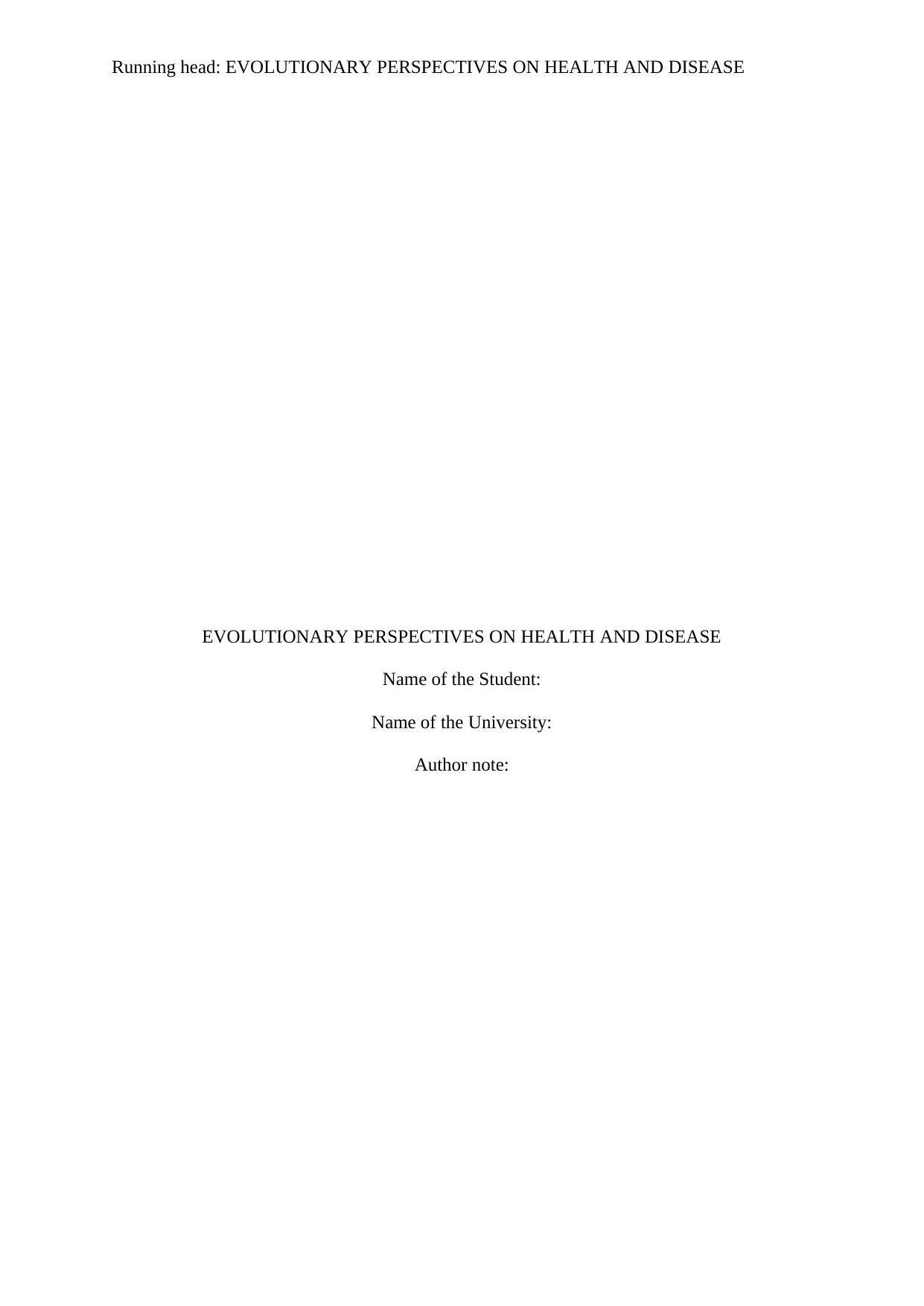
Running head: EVOLUTIONARY PERSPECTIVES ON HEALTH AND DISEASE
EVOLUTIONARY PERSPECTIVES ON HEALTH AND DISEASE
Name of the Student:
Name of the University:
Author note:
EVOLUTIONARY PERSPECTIVES ON HEALTH AND DISEASE
Name of the Student:
Name of the University:
Author note:
Secure Best Marks with AI Grader
Need help grading? Try our AI Grader for instant feedback on your assignments.
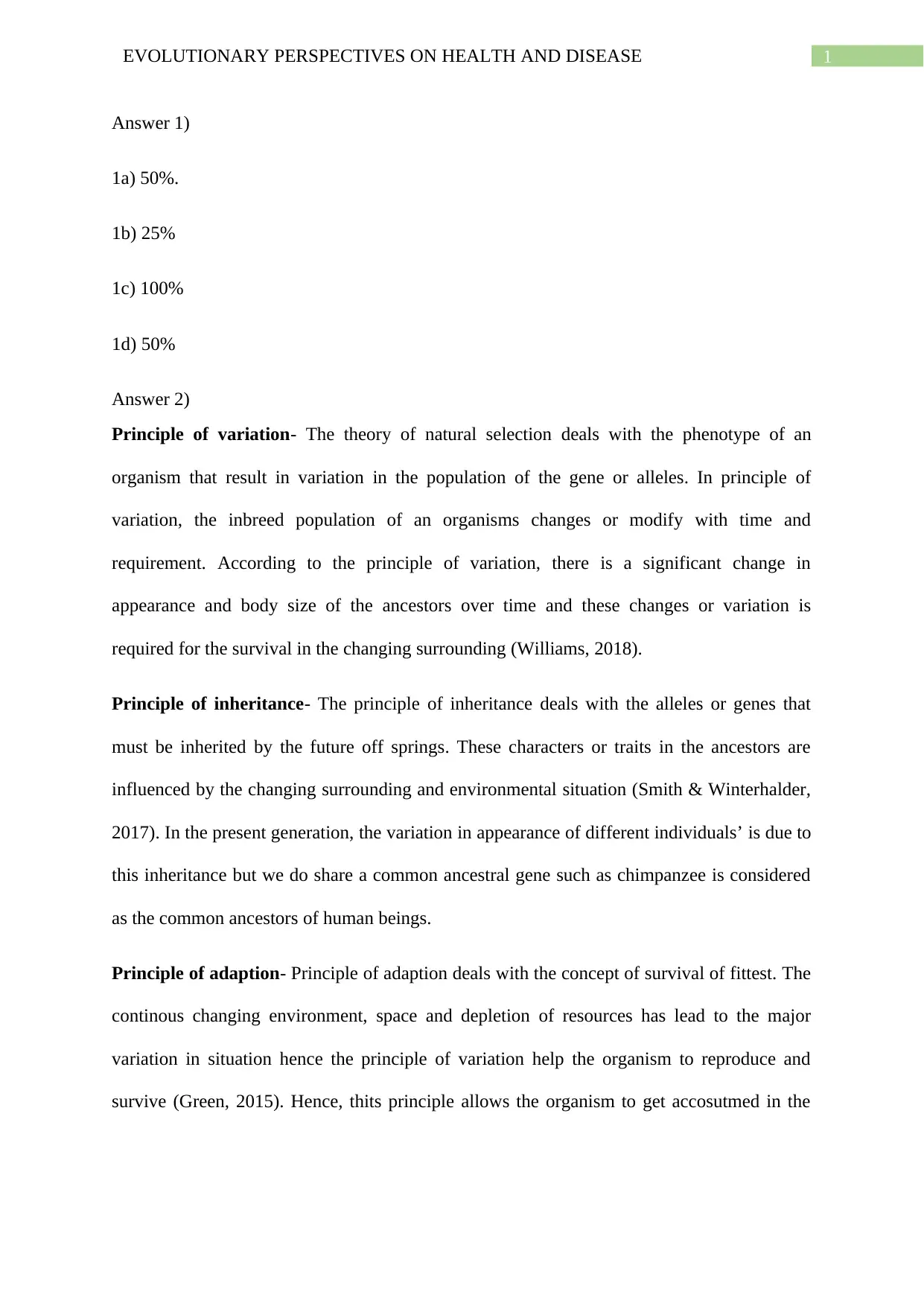
1EVOLUTIONARY PERSPECTIVES ON HEALTH AND DISEASE
Answer 1)
1a) 50%.
1b) 25%
1c) 100%
1d) 50%
Answer 2)
Principle of variation- The theory of natural selection deals with the phenotype of an
organism that result in variation in the population of the gene or alleles. In principle of
variation, the inbreed population of an organisms changes or modify with time and
requirement. According to the principle of variation, there is a significant change in
appearance and body size of the ancestors over time and these changes or variation is
required for the survival in the changing surrounding (Williams, 2018).
Principle of inheritance- The principle of inheritance deals with the alleles or genes that
must be inherited by the future off springs. These characters or traits in the ancestors are
influenced by the changing surrounding and environmental situation (Smith & Winterhalder,
2017). In the present generation, the variation in appearance of different individuals’ is due to
this inheritance but we do share a common ancestral gene such as chimpanzee is considered
as the common ancestors of human beings.
Principle of adaption- Principle of adaption deals with the concept of survival of fittest. The
continous changing environment, space and depletion of resources has lead to the major
variation in situation hence the principle of variation help the organism to reproduce and
survive (Green, 2015). Hence, thits principle allows the organism to get accosutmed in the
Answer 1)
1a) 50%.
1b) 25%
1c) 100%
1d) 50%
Answer 2)
Principle of variation- The theory of natural selection deals with the phenotype of an
organism that result in variation in the population of the gene or alleles. In principle of
variation, the inbreed population of an organisms changes or modify with time and
requirement. According to the principle of variation, there is a significant change in
appearance and body size of the ancestors over time and these changes or variation is
required for the survival in the changing surrounding (Williams, 2018).
Principle of inheritance- The principle of inheritance deals with the alleles or genes that
must be inherited by the future off springs. These characters or traits in the ancestors are
influenced by the changing surrounding and environmental situation (Smith & Winterhalder,
2017). In the present generation, the variation in appearance of different individuals’ is due to
this inheritance but we do share a common ancestral gene such as chimpanzee is considered
as the common ancestors of human beings.
Principle of adaption- Principle of adaption deals with the concept of survival of fittest. The
continous changing environment, space and depletion of resources has lead to the major
variation in situation hence the principle of variation help the organism to reproduce and
survive (Green, 2015). Hence, thits principle allows the organism to get accosutmed in the
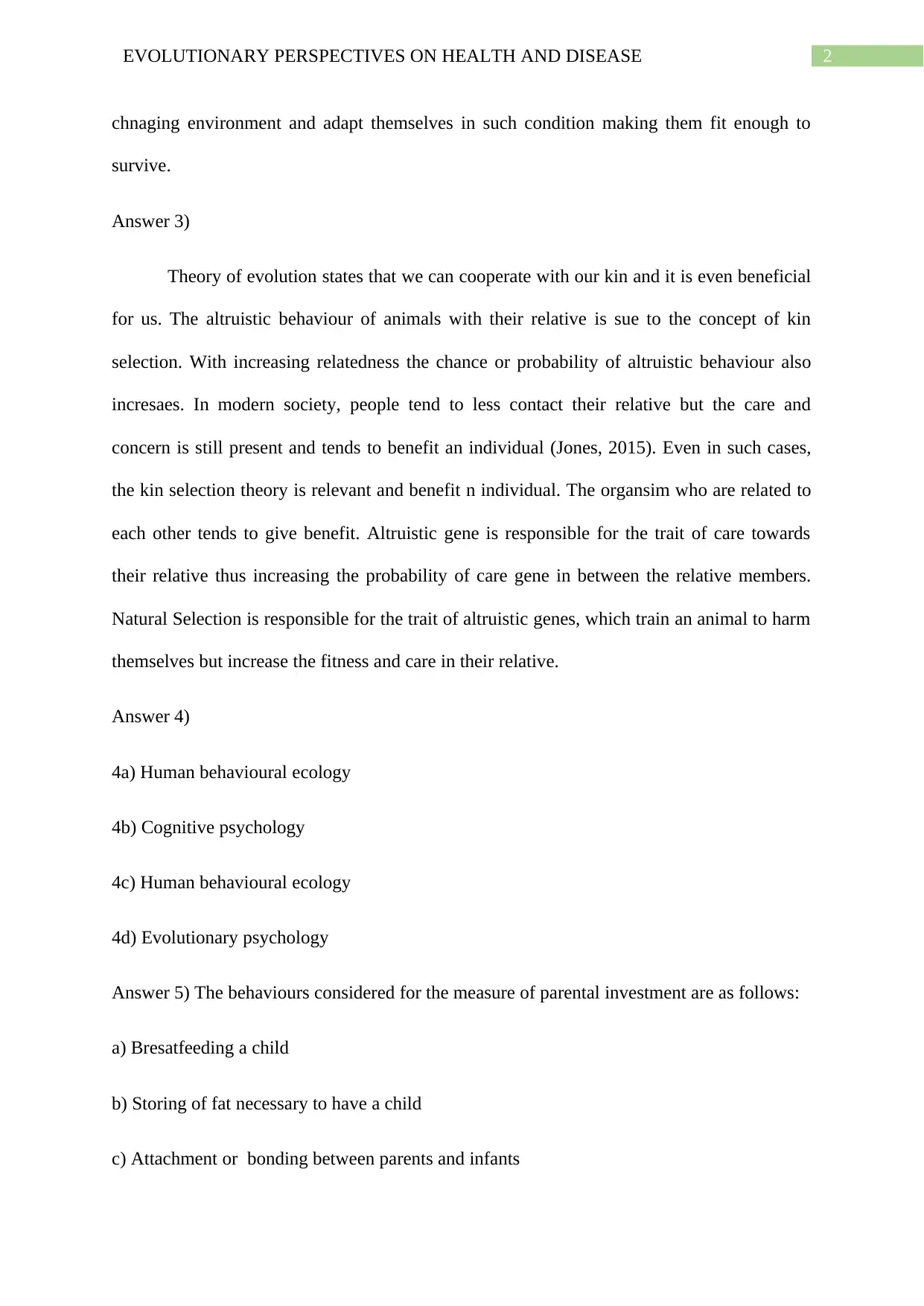
2EVOLUTIONARY PERSPECTIVES ON HEALTH AND DISEASE
chnaging environment and adapt themselves in such condition making them fit enough to
survive.
Answer 3)
Theory of evolution states that we can cooperate with our kin and it is even beneficial
for us. The altruistic behaviour of animals with their relative is sue to the concept of kin
selection. With increasing relatedness the chance or probability of altruistic behaviour also
incresaes. In modern society, people tend to less contact their relative but the care and
concern is still present and tends to benefit an individual (Jones, 2015). Even in such cases,
the kin selection theory is relevant and benefit n individual. The organsim who are related to
each other tends to give benefit. Altruistic gene is responsible for the trait of care towards
their relative thus increasing the probability of care gene in between the relative members.
Natural Selection is responsible for the trait of altruistic genes, which train an animal to harm
themselves but increase the fitness and care in their relative.
Answer 4)
4a) Human behavioural ecology
4b) Cognitive psychology
4c) Human behavioural ecology
4d) Evolutionary psychology
Answer 5) The behaviours considered for the measure of parental investment are as follows:
a) Bresatfeeding a child
b) Storing of fat necessary to have a child
c) Attachment or bonding between parents and infants
chnaging environment and adapt themselves in such condition making them fit enough to
survive.
Answer 3)
Theory of evolution states that we can cooperate with our kin and it is even beneficial
for us. The altruistic behaviour of animals with their relative is sue to the concept of kin
selection. With increasing relatedness the chance or probability of altruistic behaviour also
incresaes. In modern society, people tend to less contact their relative but the care and
concern is still present and tends to benefit an individual (Jones, 2015). Even in such cases,
the kin selection theory is relevant and benefit n individual. The organsim who are related to
each other tends to give benefit. Altruistic gene is responsible for the trait of care towards
their relative thus increasing the probability of care gene in between the relative members.
Natural Selection is responsible for the trait of altruistic genes, which train an animal to harm
themselves but increase the fitness and care in their relative.
Answer 4)
4a) Human behavioural ecology
4b) Cognitive psychology
4c) Human behavioural ecology
4d) Evolutionary psychology
Answer 5) The behaviours considered for the measure of parental investment are as follows:
a) Bresatfeeding a child
b) Storing of fat necessary to have a child
c) Attachment or bonding between parents and infants
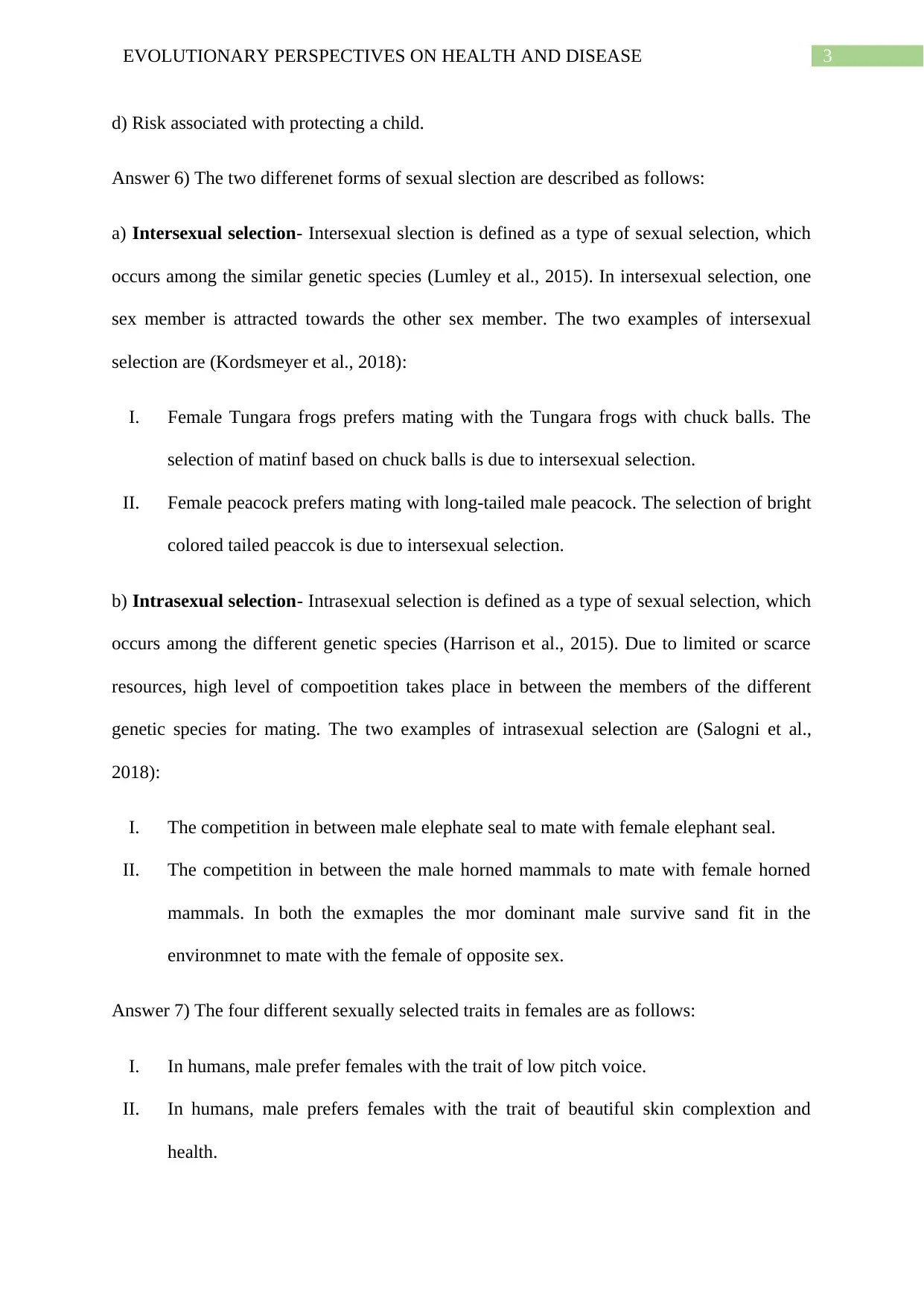
3EVOLUTIONARY PERSPECTIVES ON HEALTH AND DISEASE
d) Risk associated with protecting a child.
Answer 6) The two differenet forms of sexual slection are described as follows:
a) Intersexual selection- Intersexual slection is defined as a type of sexual selection, which
occurs among the similar genetic species (Lumley et al., 2015). In intersexual selection, one
sex member is attracted towards the other sex member. The two examples of intersexual
selection are (Kordsmeyer et al., 2018):
I. Female Tungara frogs prefers mating with the Tungara frogs with chuck balls. The
selection of matinf based on chuck balls is due to intersexual selection.
II. Female peacock prefers mating with long-tailed male peacock. The selection of bright
colored tailed peaccok is due to intersexual selection.
b) Intrasexual selection- Intrasexual selection is defined as a type of sexual selection, which
occurs among the different genetic species (Harrison et al., 2015). Due to limited or scarce
resources, high level of compoetition takes place in between the members of the different
genetic species for mating. The two examples of intrasexual selection are (Salogni et al.,
2018):
I. The competition in between male elephate seal to mate with female elephant seal.
II. The competition in between the male horned mammals to mate with female horned
mammals. In both the exmaples the mor dominant male survive sand fit in the
environmnet to mate with the female of opposite sex.
Answer 7) The four different sexually selected traits in females are as follows:
I. In humans, male prefer females with the trait of low pitch voice.
II. In humans, male prefers females with the trait of beautiful skin complextion and
health.
d) Risk associated with protecting a child.
Answer 6) The two differenet forms of sexual slection are described as follows:
a) Intersexual selection- Intersexual slection is defined as a type of sexual selection, which
occurs among the similar genetic species (Lumley et al., 2015). In intersexual selection, one
sex member is attracted towards the other sex member. The two examples of intersexual
selection are (Kordsmeyer et al., 2018):
I. Female Tungara frogs prefers mating with the Tungara frogs with chuck balls. The
selection of matinf based on chuck balls is due to intersexual selection.
II. Female peacock prefers mating with long-tailed male peacock. The selection of bright
colored tailed peaccok is due to intersexual selection.
b) Intrasexual selection- Intrasexual selection is defined as a type of sexual selection, which
occurs among the different genetic species (Harrison et al., 2015). Due to limited or scarce
resources, high level of compoetition takes place in between the members of the different
genetic species for mating. The two examples of intrasexual selection are (Salogni et al.,
2018):
I. The competition in between male elephate seal to mate with female elephant seal.
II. The competition in between the male horned mammals to mate with female horned
mammals. In both the exmaples the mor dominant male survive sand fit in the
environmnet to mate with the female of opposite sex.
Answer 7) The four different sexually selected traits in females are as follows:
I. In humans, male prefer females with the trait of low pitch voice.
II. In humans, male prefers females with the trait of beautiful skin complextion and
health.
Secure Best Marks with AI Grader
Need help grading? Try our AI Grader for instant feedback on your assignments.
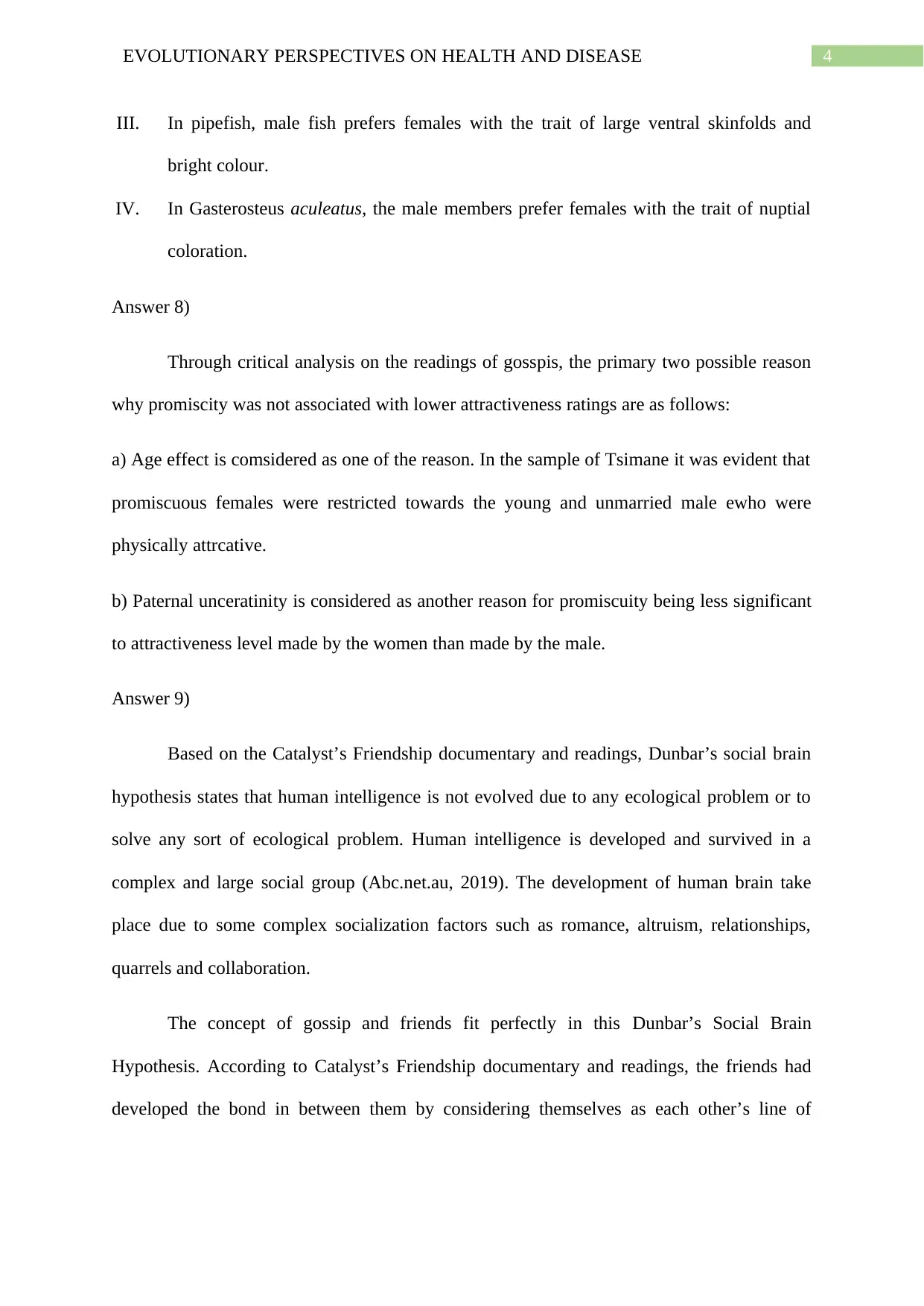
4EVOLUTIONARY PERSPECTIVES ON HEALTH AND DISEASE
III. In pipefish, male fish prefers females with the trait of large ventral skinfolds and
bright colour.
IV. In Gasterosteus aculeatus, the male members prefer females with the trait of nuptial
coloration.
Answer 8)
Through critical analysis on the readings of gosspis, the primary two possible reason
why promiscity was not associated with lower attractiveness ratings are as follows:
a) Age effect is comsidered as one of the reason. In the sample of Tsimane it was evident that
promiscuous females were restricted towards the young and unmarried male ewho were
physically attrcative.
b) Paternal unceratinity is considered as another reason for promiscuity being less significant
to attractiveness level made by the women than made by the male.
Answer 9)
Based on the Catalyst’s Friendship documentary and readings, Dunbar’s social brain
hypothesis states that human intelligence is not evolved due to any ecological problem or to
solve any sort of ecological problem. Human intelligence is developed and survived in a
complex and large social group (Abc.net.au, 2019). The development of human brain take
place due to some complex socialization factors such as romance, altruism, relationships,
quarrels and collaboration.
The concept of gossip and friends fit perfectly in this Dunbar’s Social Brain
Hypothesis. According to Catalyst’s Friendship documentary and readings, the friends had
developed the bond in between them by considering themselves as each other’s line of
III. In pipefish, male fish prefers females with the trait of large ventral skinfolds and
bright colour.
IV. In Gasterosteus aculeatus, the male members prefer females with the trait of nuptial
coloration.
Answer 8)
Through critical analysis on the readings of gosspis, the primary two possible reason
why promiscity was not associated with lower attractiveness ratings are as follows:
a) Age effect is comsidered as one of the reason. In the sample of Tsimane it was evident that
promiscuous females were restricted towards the young and unmarried male ewho were
physically attrcative.
b) Paternal unceratinity is considered as another reason for promiscuity being less significant
to attractiveness level made by the women than made by the male.
Answer 9)
Based on the Catalyst’s Friendship documentary and readings, Dunbar’s social brain
hypothesis states that human intelligence is not evolved due to any ecological problem or to
solve any sort of ecological problem. Human intelligence is developed and survived in a
complex and large social group (Abc.net.au, 2019). The development of human brain take
place due to some complex socialization factors such as romance, altruism, relationships,
quarrels and collaboration.
The concept of gossip and friends fit perfectly in this Dunbar’s Social Brain
Hypothesis. According to Catalyst’s Friendship documentary and readings, the friends had
developed the bond in between them by considering themselves as each other’s line of

5EVOLUTIONARY PERSPECTIVES ON HEALTH AND DISEASE
defence. The faith they had on each other, showed that there was major involvement of
complex socialization factor that helped them to evolve as a friend.
defence. The faith they had on each other, showed that there was major involvement of
complex socialization factor that helped them to evolve as a friend.
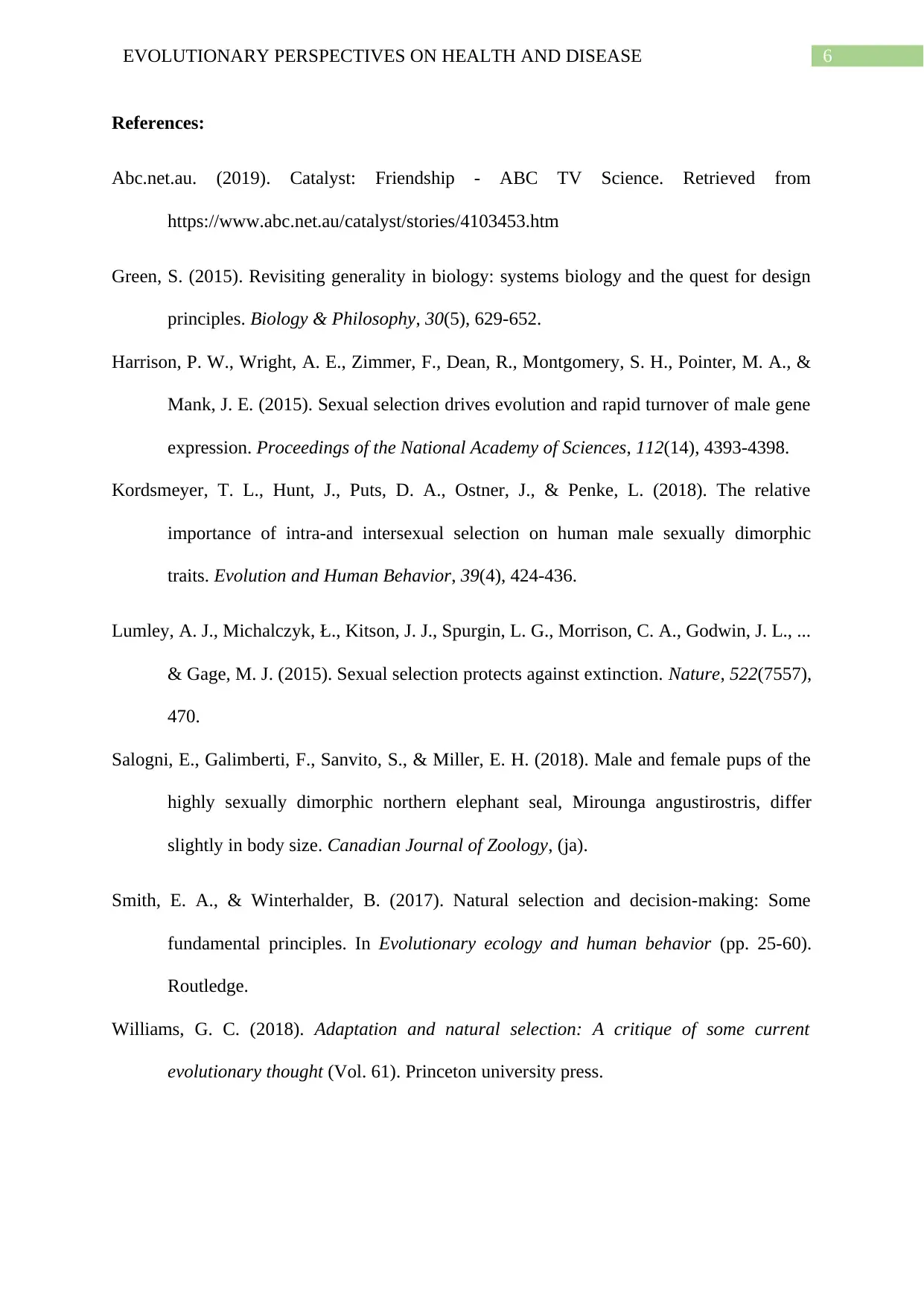
6EVOLUTIONARY PERSPECTIVES ON HEALTH AND DISEASE
References:
Abc.net.au. (2019). Catalyst: Friendship - ABC TV Science. Retrieved from
https://www.abc.net.au/catalyst/stories/4103453.htm
Green, S. (2015). Revisiting generality in biology: systems biology and the quest for design
principles. Biology & Philosophy, 30(5), 629-652.
Harrison, P. W., Wright, A. E., Zimmer, F., Dean, R., Montgomery, S. H., Pointer, M. A., &
Mank, J. E. (2015). Sexual selection drives evolution and rapid turnover of male gene
expression. Proceedings of the National Academy of Sciences, 112(14), 4393-4398.
Kordsmeyer, T. L., Hunt, J., Puts, D. A., Ostner, J., & Penke, L. (2018). The relative
importance of intra-and intersexual selection on human male sexually dimorphic
traits. Evolution and Human Behavior, 39(4), 424-436.
Lumley, A. J., Michalczyk, Ł., Kitson, J. J., Spurgin, L. G., Morrison, C. A., Godwin, J. L., ...
& Gage, M. J. (2015). Sexual selection protects against extinction. Nature, 522(7557),
470.
Salogni, E., Galimberti, F., Sanvito, S., & Miller, E. H. (2018). Male and female pups of the
highly sexually dimorphic northern elephant seal, Mirounga angustirostris, differ
slightly in body size. Canadian Journal of Zoology, (ja).
Smith, E. A., & Winterhalder, B. (2017). Natural selection and decision-making: Some
fundamental principles. In Evolutionary ecology and human behavior (pp. 25-60).
Routledge.
Williams, G. C. (2018). Adaptation and natural selection: A critique of some current
evolutionary thought (Vol. 61). Princeton university press.
References:
Abc.net.au. (2019). Catalyst: Friendship - ABC TV Science. Retrieved from
https://www.abc.net.au/catalyst/stories/4103453.htm
Green, S. (2015). Revisiting generality in biology: systems biology and the quest for design
principles. Biology & Philosophy, 30(5), 629-652.
Harrison, P. W., Wright, A. E., Zimmer, F., Dean, R., Montgomery, S. H., Pointer, M. A., &
Mank, J. E. (2015). Sexual selection drives evolution and rapid turnover of male gene
expression. Proceedings of the National Academy of Sciences, 112(14), 4393-4398.
Kordsmeyer, T. L., Hunt, J., Puts, D. A., Ostner, J., & Penke, L. (2018). The relative
importance of intra-and intersexual selection on human male sexually dimorphic
traits. Evolution and Human Behavior, 39(4), 424-436.
Lumley, A. J., Michalczyk, Ł., Kitson, J. J., Spurgin, L. G., Morrison, C. A., Godwin, J. L., ...
& Gage, M. J. (2015). Sexual selection protects against extinction. Nature, 522(7557),
470.
Salogni, E., Galimberti, F., Sanvito, S., & Miller, E. H. (2018). Male and female pups of the
highly sexually dimorphic northern elephant seal, Mirounga angustirostris, differ
slightly in body size. Canadian Journal of Zoology, (ja).
Smith, E. A., & Winterhalder, B. (2017). Natural selection and decision-making: Some
fundamental principles. In Evolutionary ecology and human behavior (pp. 25-60).
Routledge.
Williams, G. C. (2018). Adaptation and natural selection: A critique of some current
evolutionary thought (Vol. 61). Princeton university press.
1 out of 7
Your All-in-One AI-Powered Toolkit for Academic Success.
+13062052269
info@desklib.com
Available 24*7 on WhatsApp / Email
![[object Object]](/_next/static/media/star-bottom.7253800d.svg)
Unlock your academic potential
© 2024 | Zucol Services PVT LTD | All rights reserved.


